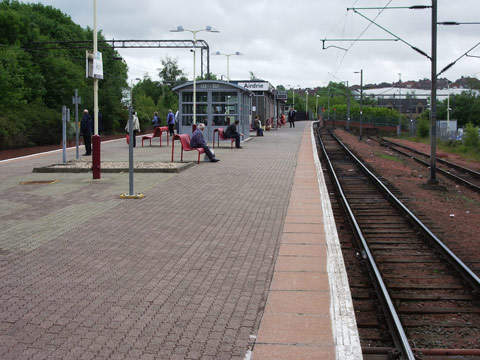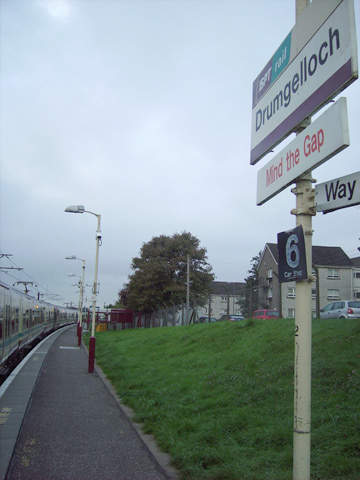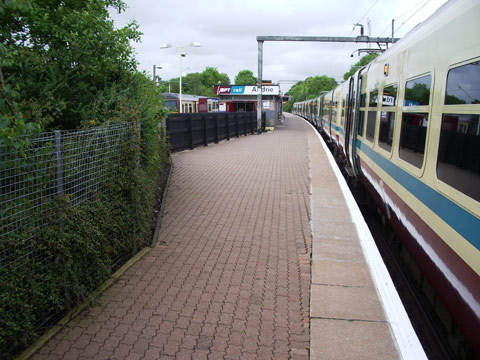The Airdrie-Bathgate Railway Link connects Edinburgh to Glasgow through Bathgate, Drumgelloch and Airdrie. It was opened to passengers in March 2011.
The route was closed for a period of more than 50 years; it closed to passengers in 1956 and freight in 1982, when the tracks were also removed.
A single track between Bathgate and Edinburgh was reopened in 1986. In 2004, the Scottish Government decided to reopen the line on the recommendations of the Central Scotland Transport Corridor Study.
The study recommended that the line be reinstated to encourage the use of public transport among the local communities and ease traffic on the nearby motorway and road networks, as well as providing better public transport in West Lothian and North Lanarkshire. The Act of Parliament commissioning the project received Royal Assent in May 2007.
Operations on the line had begsn in December 2010, but the opening of three new stations — Armadale, Blackridge and Caldercruix — was delayed due to bad weather conditions.
The Scottish Government found the project to be economically viable. It expects a return of £1.81 for every £1 spent on it.
Network Rail, the key owner and operator of the UK rail network, managed the project on behalf of Transport Scotland, which funded the £300m project.
The project reopened the link and upgraded the existing Airdrie-Drumgelloch and Bathgate-Edinburgh lines. This resulted in a double-tracked electrified railway line from Glasgow to Edinburgh.
The project
Network Rail and its team of contractors split the construction activity into three stages – advanced works, main works and final works.
In the advanced works stage, construction was carried out between Newbridge Junction and Bathgate. This involved an upgrade of the double-track Edinburgh-Bathgate line, and an upgrade for Livingston North and Uphall stations.
The main works stage involved the connection of Edinburgh and Glasgow through the construction of new stations at Armadale and Caldercruix; relocating the stations at Bathgate and Drumgelloch; and laying a double-tracked and electrified line between Bathgate and Drumgelloch stations.
The final works stage involved an upgrade of Airdrie and Livingston North stations.
The £60m contract to construct the Airdrie-Bathgate link was awarded to Balfour Beatty Rail Projects in October 2008. This included the construction of a new track between Airdrie and Bathgate, double tracking the line between Airdrie and Drumgelloch and electrifying the entire route.
During April 2009, Network Rail awarded three contracts worth £80m, £14m and £6m to Carillion, BAM Nuttall and C Spencer respectively. Carillion built the three stations Caldercruix, Armadale and Drumgelloch, and also carried out certain ground treatment and filling activities. The new Bathgate station, new platform at Airdrie, and bridge and earthworks were delivered by BAM Nuttall. C Spencer was responsible for developing the light maintenance depot at Bathgate.
The proposal to construct a new station at Blackridge was approved by the West Lothian Council in March 2009. Network Rail designed and integrated the construction of the station into the project.
Infrastructure
Double tracking of the rail link began in June 2008 and was completed in October of the same year. The construction and upgrades of the railway lines and stations began in late 2008. Work on the rail link between Airdrie and Bathgate began in mid-2009.
The National Cycle Route 75 is a 16km path across central Scotland, developed following the closure of the Airdrie and Bathgate link in 1982. The cycle path was closed in October 2008, to facilitate railway line construction work between Bathgate and Drumgelloch. Network Rail invested £7.3m to construct a cycle path parallel to the railway line, which opened in December 2010.
By December 2009, some 17 bridges had been dismantled along the route, and 14 new ones constructed – this was to allow for double-tracking and electrification along the route. Journey time between the terminal stations, Edinburgh Waverley and Glasgow Queen Street, is 74 minutes. Four trains stop at each station every hour, except for Armadale and Caldercruix, which will only have two services per hour.
A new depot has been constructed at Bathgate station, and a parking lot for 400 cars opened in December 2010. Bathgate, which opened in October 2010, is 150m long and able to accommodate a nine-carriage train, the same design that used for all other stations. It has CCTV that is monitored from a regional control room, cycle storage and park-and-ride facilities.
Drumgelloch station closed in May 2010. It was being relocated to a new site, and opened in the first quarter of 2011. The relocation work also included parking space for 358 cars.
The route has 69 bridges, which have all been upgraded or replaced. The route has also reduced traffic congestion on the M8.
Rolling stock
The line uses Class 380 and Class 334 trains. These are used on the Ayrshire, Inverclyde and Renfrewshire routes to and from Glasgow Central, and between Glasgow and Edinburgh via the Airdrie and Bathgate line.
Network Rail runs two trains an hour between Edinburgh and Glasgow. The service will be increased to four trains an hour in the future.
Environmental impact
Scottish National Heritage and the Scottish Environment Protection Agency completed an environmental impact assessment and a landscape and habitat management plan.
The key impact areas of the railway construction were defined and ways to reduce such effects suggested. Network Rail also conducted surveys to identify endangered species.
The key environmental benefits of the railway link include electrified lines, reducing carbon emissions; 1,000 parking spaces at stations, encouraging people to park and travel; and a cycle path.






